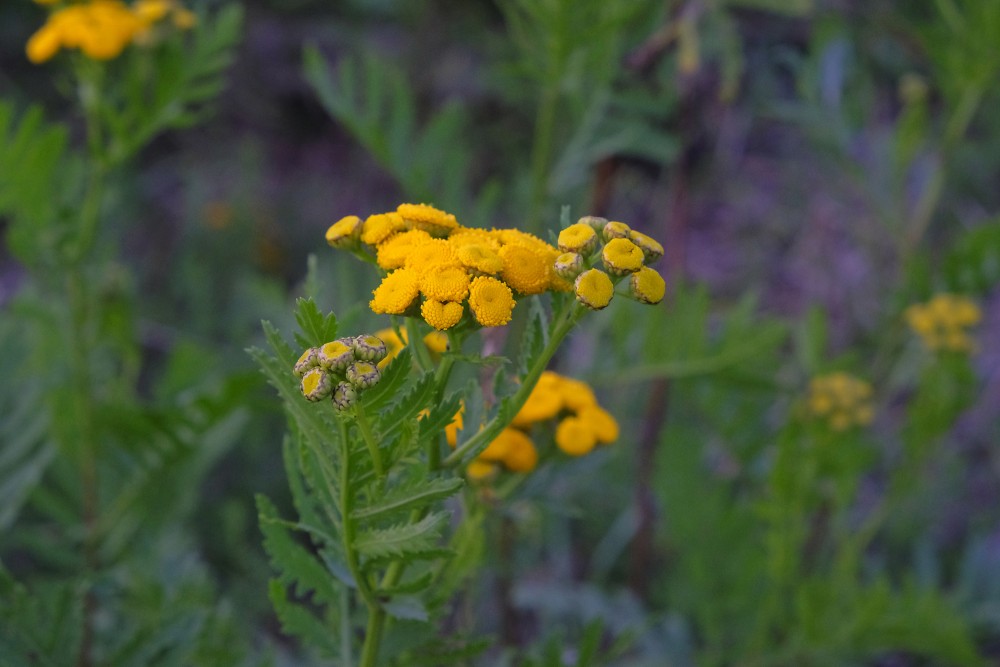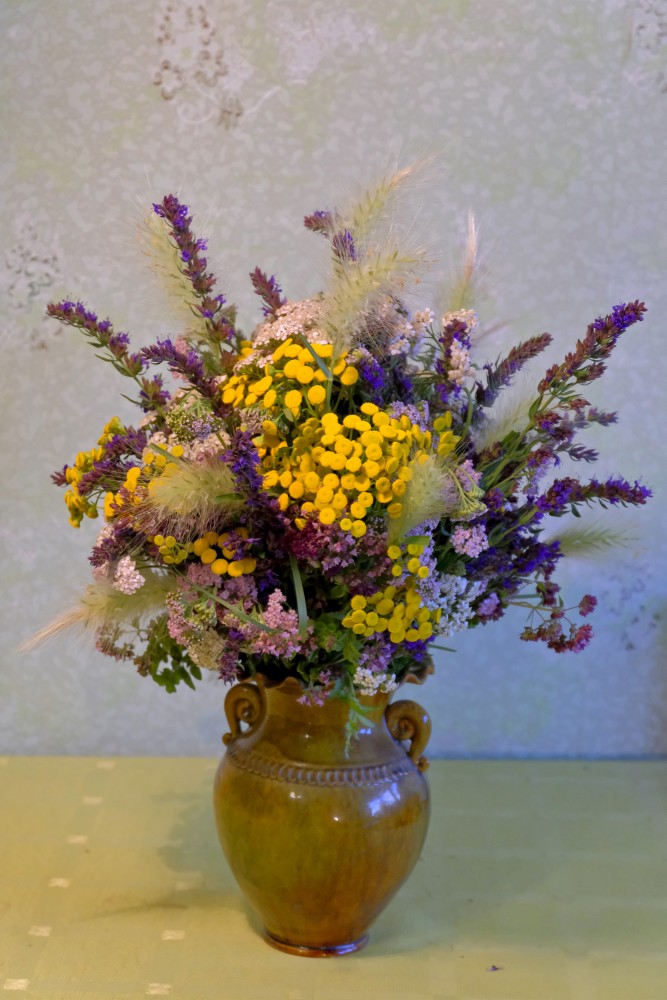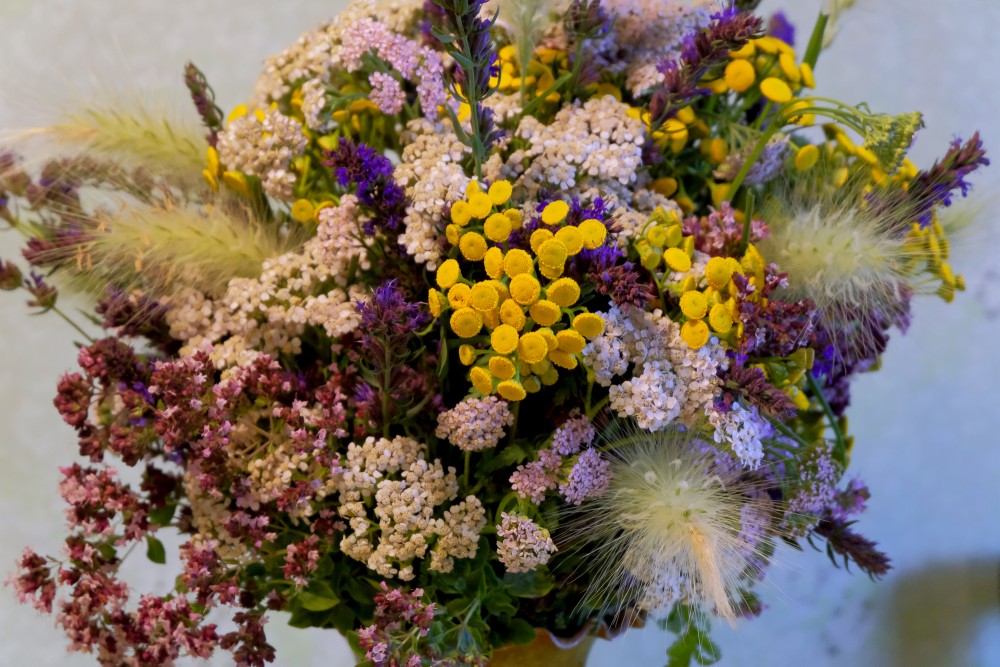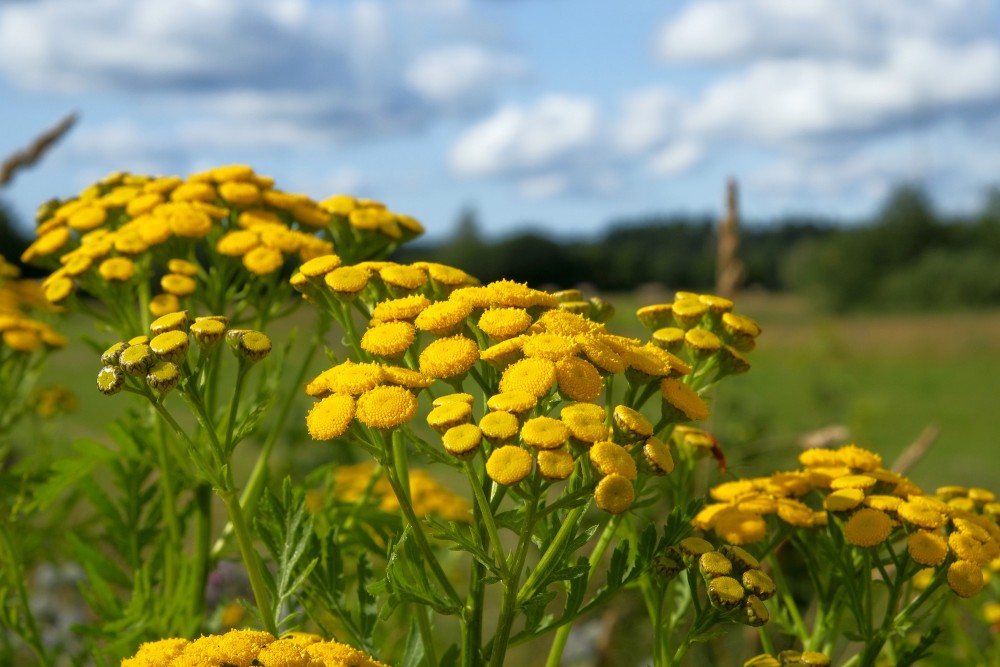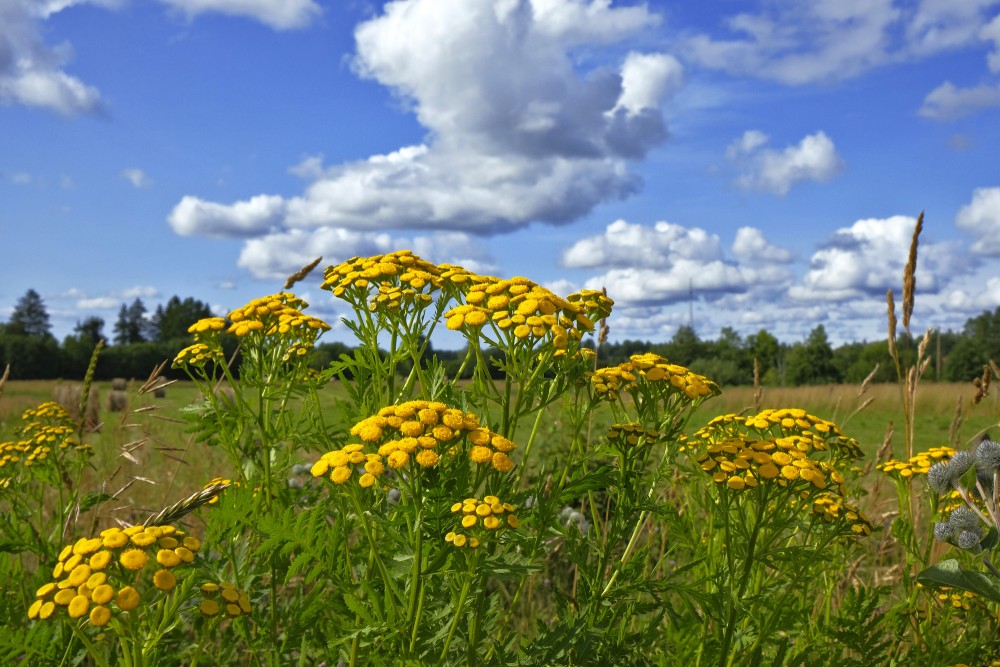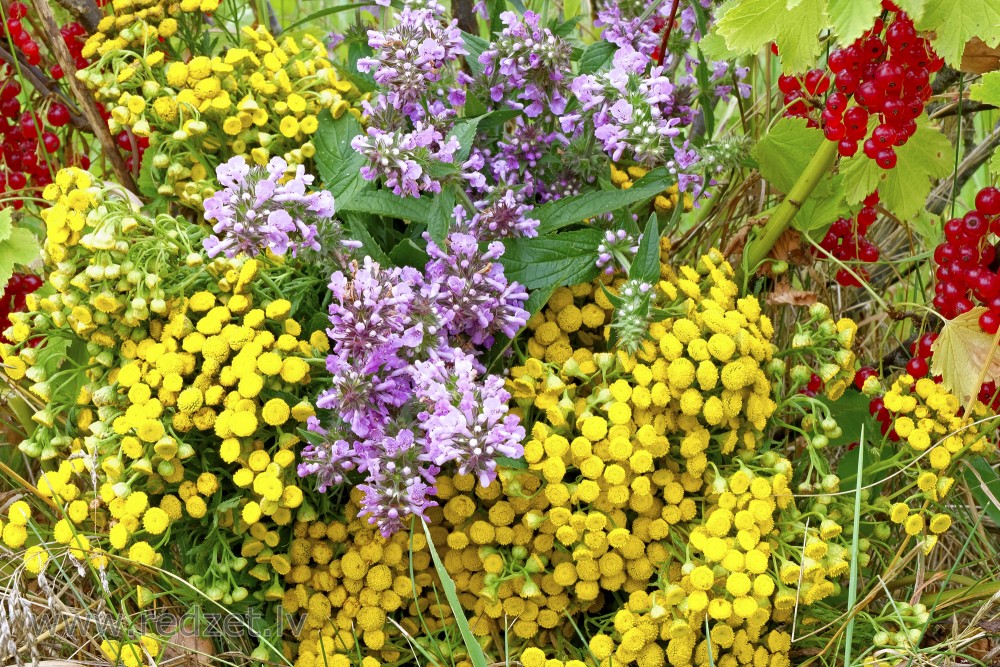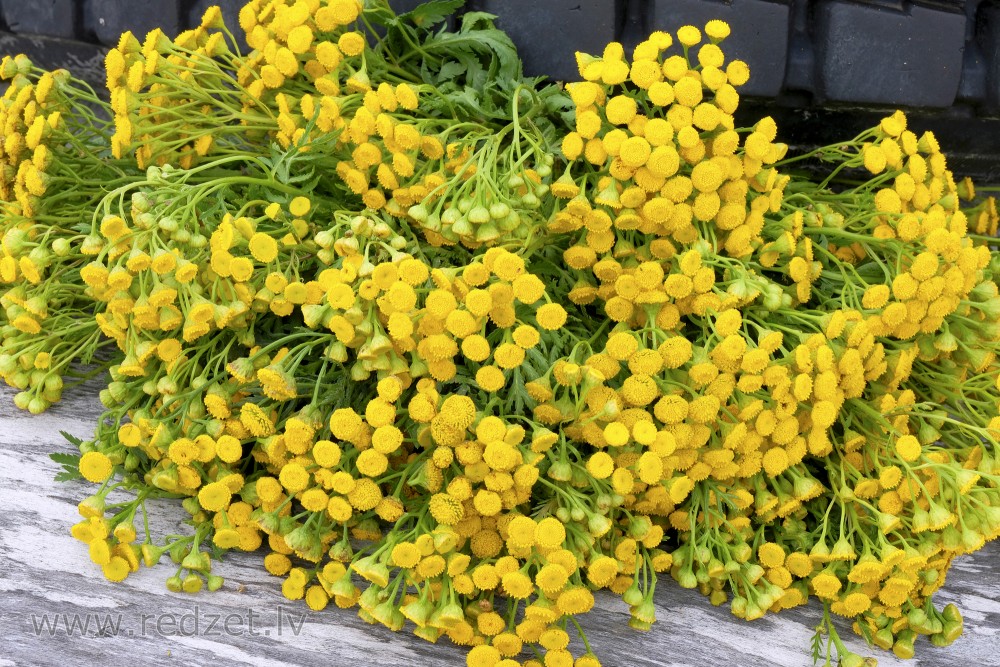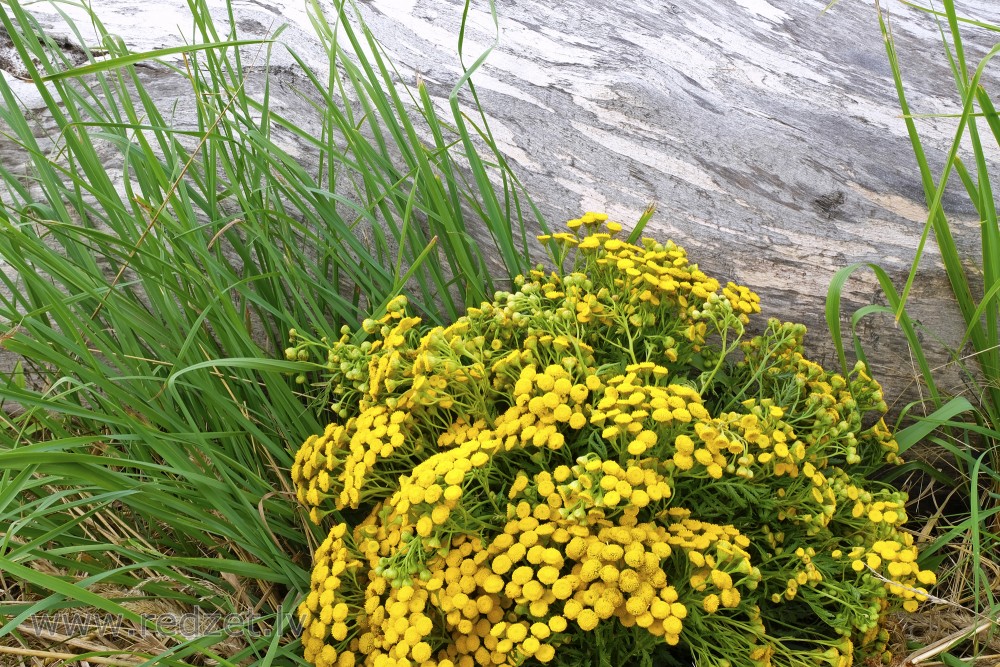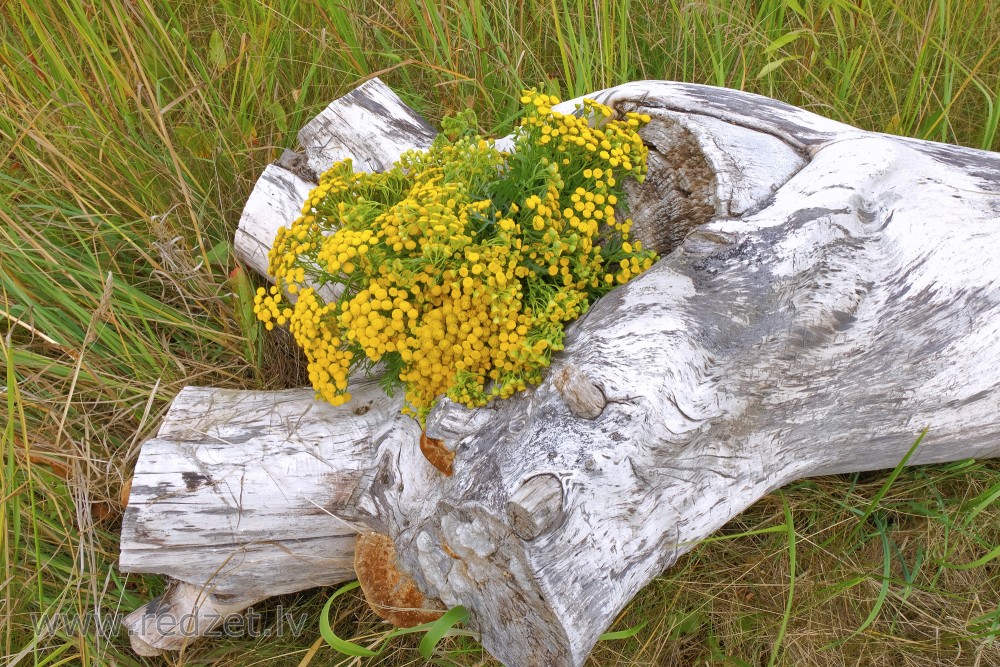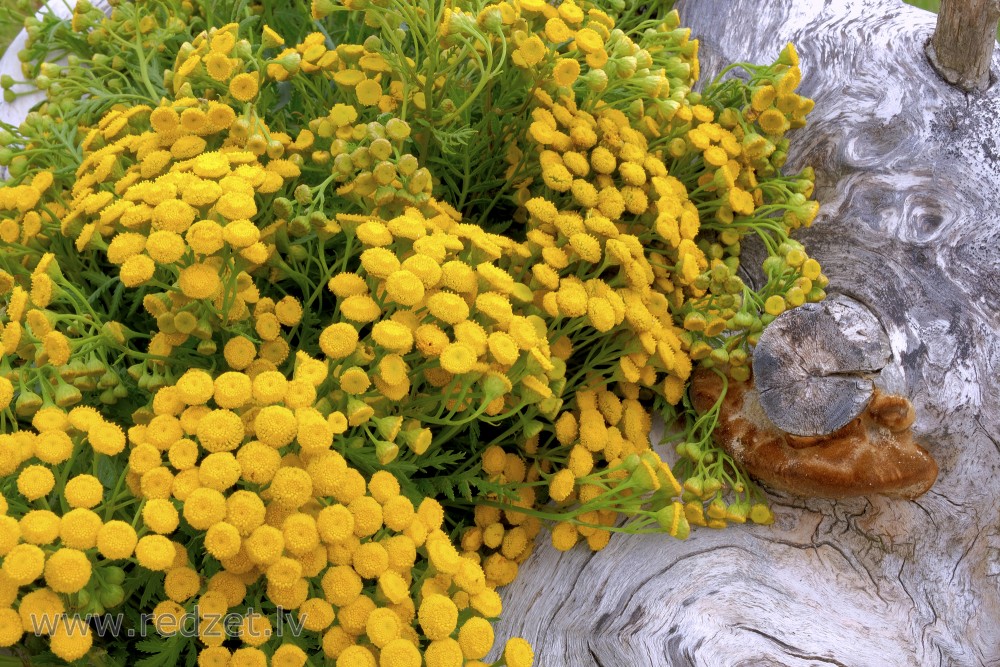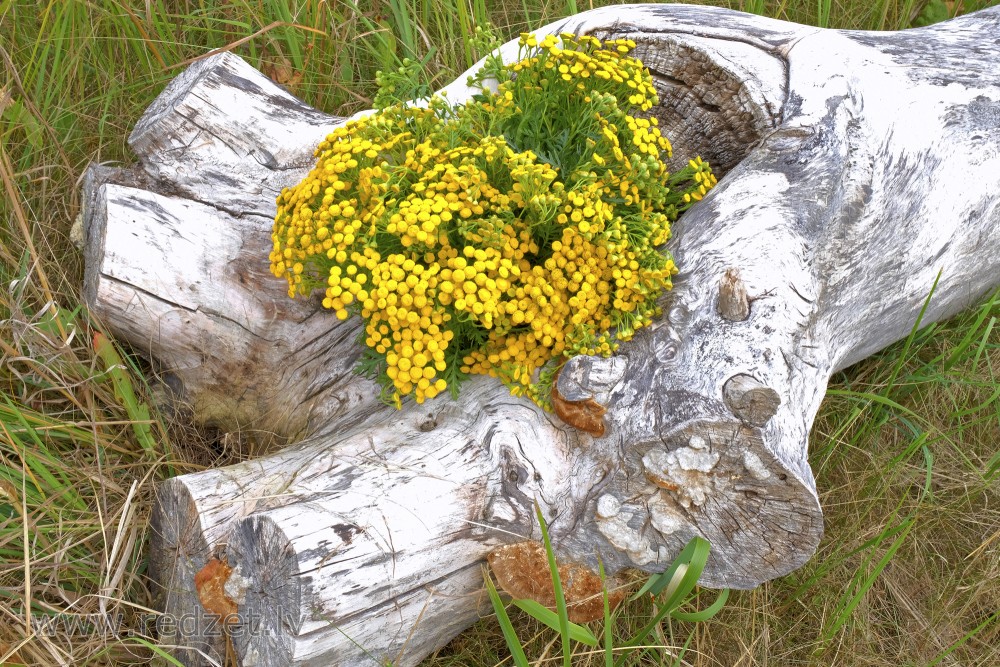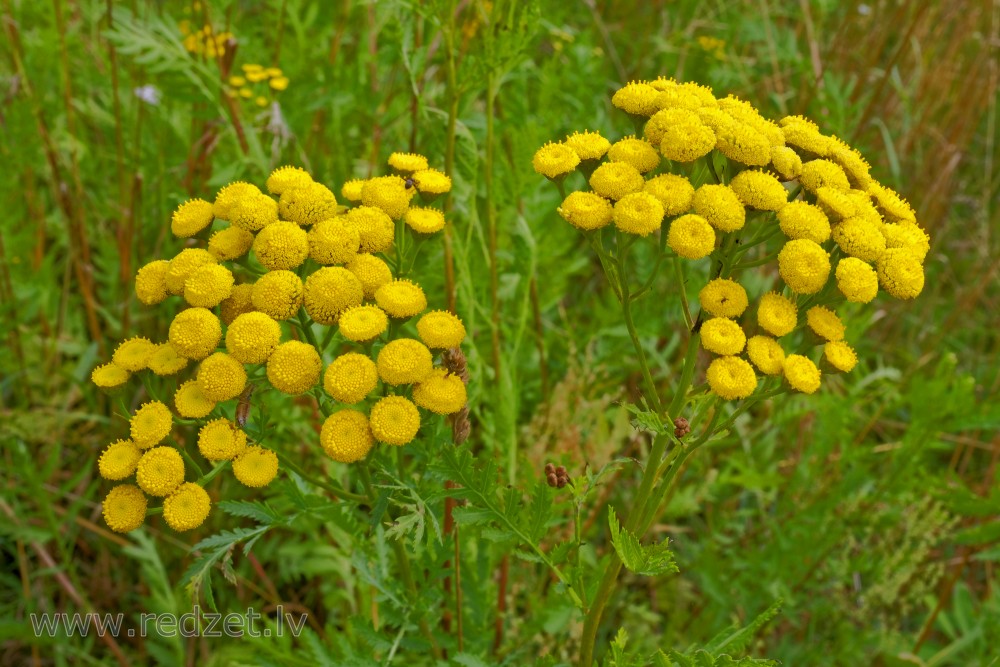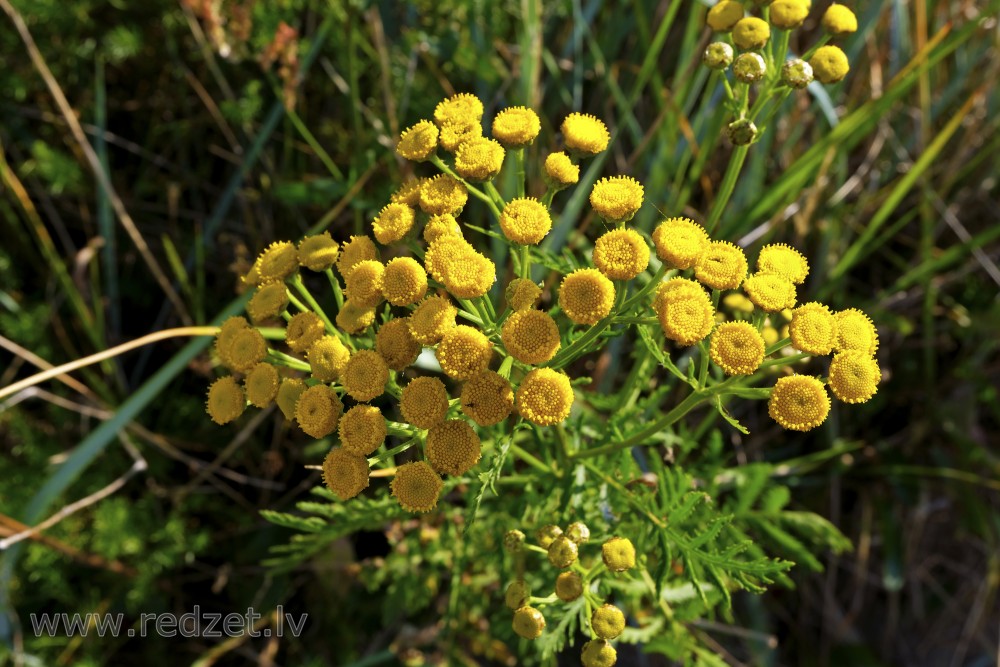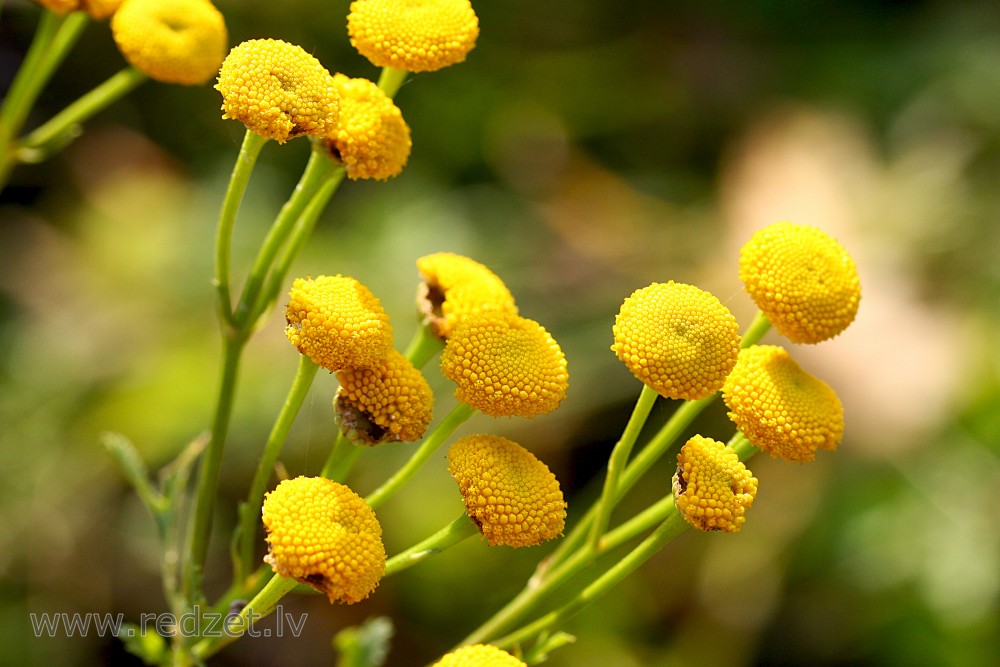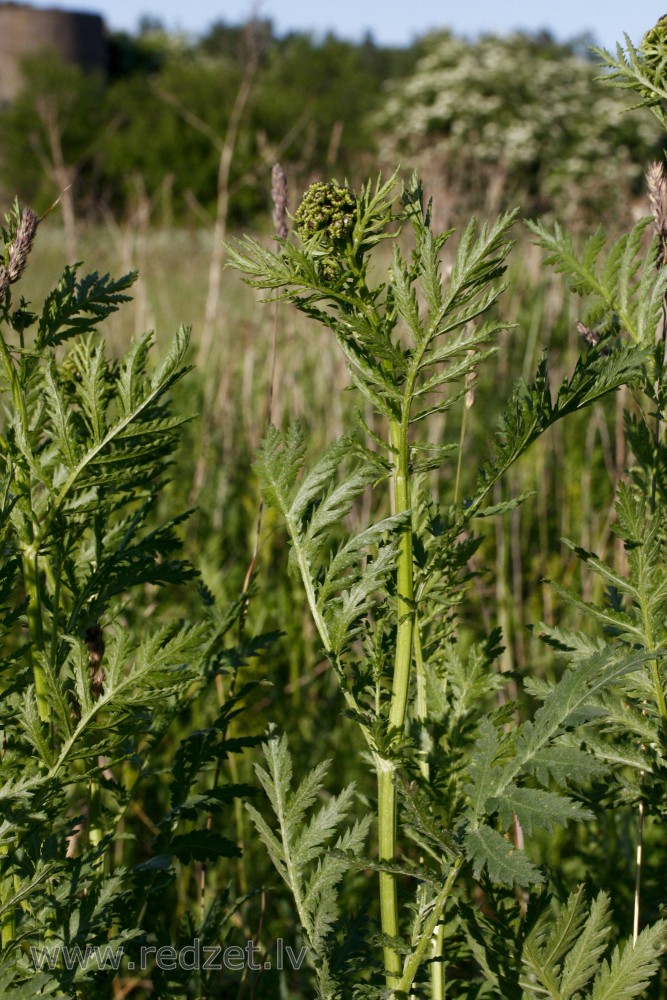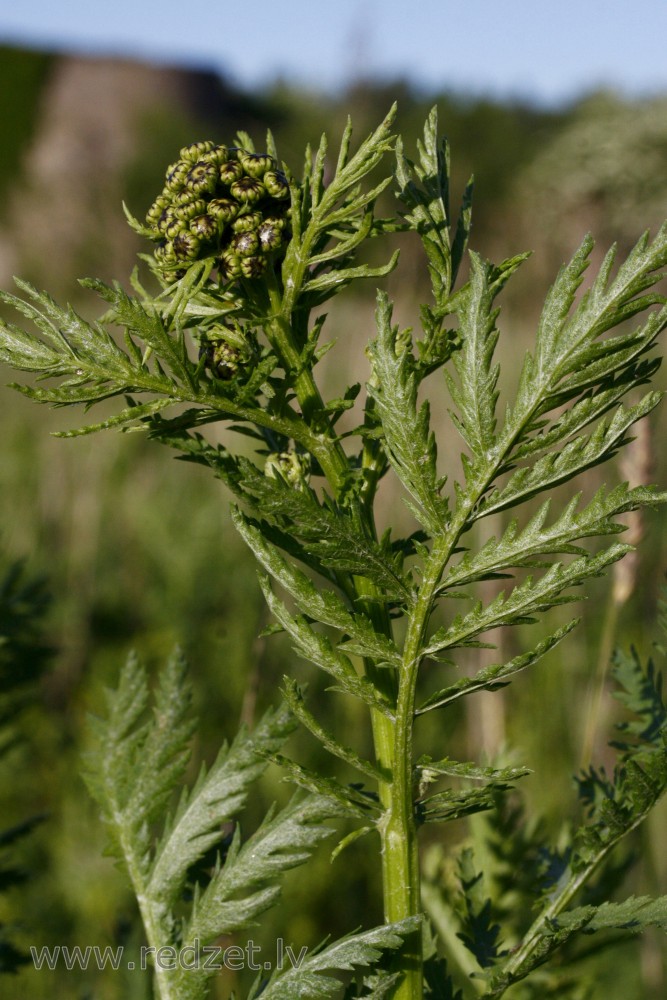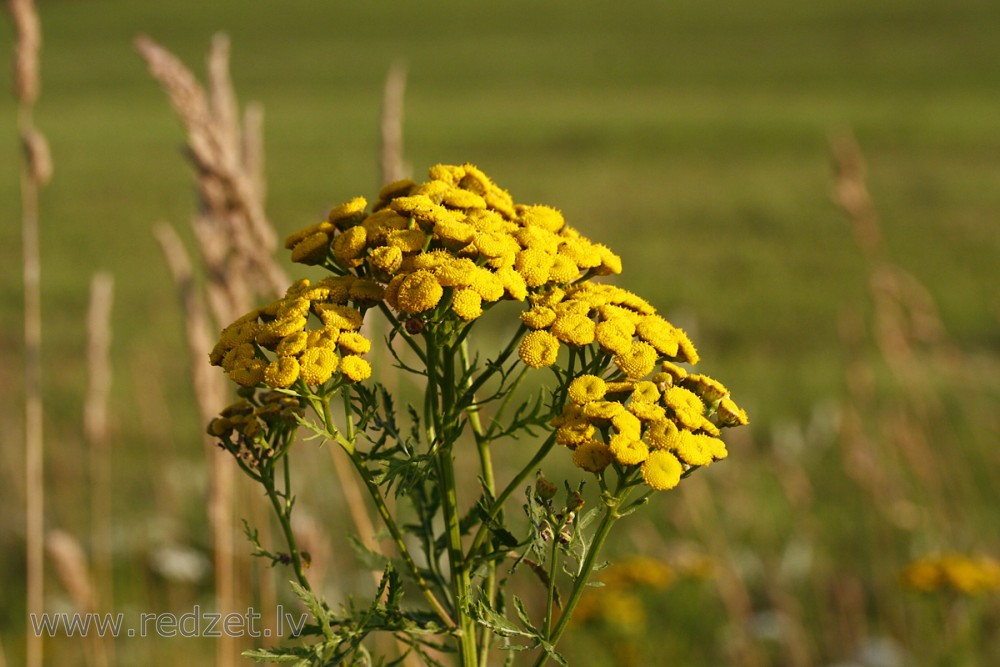Tansy (Tanacetum vulgare)
Tansy (Tanacetum vulgare) is a perennial, herbaceous flowering plant of the aster family, native to temperate Europe and Asia. It has been introduced to other parts of the world, including North America, and in some areas has become invasive. It is also known as common tansy, bitter buttons, cow bitter, or golden buttons.
Description
Tansy is a flowering herbaceous plant with finely divided compound leaves and yellow, button-like flowers. It has a stout, somewhat reddish, erect stem, usually smooth, 50–150 cm (20–59 in) tall, and branching near the top. The leaves are alternate, 10–15 cm (3.9–5.9 in) long and are pinnately lobed, divided almost to the center into about seven pairs of segments, or lobes, which are again divided into smaller lobes having saw-toothed edges, giving the leaf a somewhat fernlike appearance. The roundish, flat-topped, button-like, yellow flower heads are produced in terminal clusters from mid-to-late summer. The scent is similar to that of camphor with hints of rosemary. The leaves and flowers are toxic if consumed in large quantities; the volatile oil contains toxic compounds including thujone, which can cause convulsions and liver and brain damage. Some insects, notably the tansy beetle Chrysolina graminis, have resistance to the toxins and subsist almost exclusively on the plant.
History and distribution
Tansy is native to Eurasia; it is found in almost all parts of mainland Europe, as well as Britain and Ireland. It is absent from Siberia and some of the Mediterranean islands. The ancient Greeks may have been the first to cultivate it as a medicinal herb. In the sixteenth century it was considered to be "necessary for a garden" in Britain.
History of uses
Tansy has a long history of use. It was first recorded as being cultivated by the ancient Greeks for medicinal purposes. In the 8th century AD it was grown in the herb gardens of Charlemagne and by Benedictine monks of the Swiss monastery of Saint Gall. Tansy was used to treat intestinal worms, rheumatism, digestive problems, fevers, sores, and to bring out measles.
During the Middle Ages and later, high doses were used to induce abortions. Contradictorily, tansy was also used to help women conceive and to prevent miscarriages. In the 15th century, Christians began serving tansy with Lenten meals to commemorate the bitter herbs eaten by the Israelites. Tansy was thought to have the added Lenten benefits of controlling flatulence brought on by days of eating fish and pulses and of preventing the intestinal worms believed to be caused by eating fish during Lent.
Tansy was used as a face wash and was reported to lighten and purify the skin. In the 19th century, Irish folklore suggested that bathing in a solution of tansy and salts would cure joint pain. Although most of its medicinal uses have been discredited, tansy is still a component of some medicines and is listed by the United States Pharmacopeia as a treatment for fevers, feverish colds, and jaundice.
Toxicity
Many tansy species contain a volatile oil which can cause contact dermatitis in sensitive individuals. If taken internally, toxic metabolites are produced as the oil is broken down in the liver and digestive tract. It is highly toxic to internal parasites, and for centuries tansy tea has been prescribed by herbalists to expel worms. Tansy is an effective insecticide and is highly toxic to arthropods. Because it contains thujone, the U.S. FDA limits the use of tansy to alcoholic beverages, and the final product must be thujone-free. Tanacetum annuum is often confused with common tansy (Tanacetum vulgare) but the former produces an essential oil that is completely different chemically as it contains no thujone and high amounts of chamazulene making the oil dark blue in color, giving rise to it common name of Blue Tansy Oil. Despite claims by some unethical resellers of essential oils who adulterate the very expensive Blue Tansy (Tanacetum annuum) oil with the much cheaper oil from Tanacetum vulgare, it should be noted that the oil from Tanacetum vulgare is never blue in color as it contains no chamazulene. For this reason a high thujone oil from Tanacetum vulgare should never be referred to as "Blue Tansy" oil and any such blue oil containing significant thujone is an adulterated product.
The active components of the volatile oil include 1,8-cineole, trans-thujone, camphor and myrtenol, with the quantities and proportions of each varying seasonally and from plant to plant.
1,8-Cineole is a toxin believed to defend the plant leaves against attacks by herbivores.
en.wikipedia.org
Tansy
Tanacetum vulgareName also: Common Tansy
- Family: Daisy Family – Compositae, subfamily Asteroideae
- (formerly Aster Family – Asteraceae)
- Growing form: Perennial herb. Rootstock branching.
- Height: 30–150 cm (12–60 in.). Stem woody at base, rigid, branching, almost glabrous, usually reddish brown. Strong herb-like fragrance.
- Flower: Single flower-like, usually 7–11 mm (0.28–0.44 in.) capitula, surrounded by involucral bracts. Capitula’s ray-florets lacking; disc florets deep yellow, tubular, small. Stamens 5. Pistil of 2 fused carpels. Involucral bracts in 3 rows, with ragged margins, glabrous. Capitula 10–60 borne in a dense corymbose cluster.
- Leaves: Alternate, stalkless–short-stalked. Blade usually pinnately lobed, sparsely haired, dotted with glands, lobes lanceolate, with tapered tips, serrated–pinnately lobed. Sometimes blade 2 times pinnately lobed, lobes densely toothed, crinkled (f. crispum).
- Fruit: Many-ridged achene, tip with shallow, crowned by a low membranous ring.
- Habitat: Gravelly and stony sea-shores, bird rocks, roadsides, rocky outcrops, inland often around inhabited areas. Also ornamental, in many places left over and an escape from old gardens.
- Flowering time: July–September(–October).
Tansy only grows in Finland as a native plant on rocky seashores, but it has travelled inland along roadsides as far as the Arctic Circle and sometimes even further north. In bygone times it was transplanted close to inhabited areas as a medicinal, culinary and ornamental herb. Tansy was used as a very versatile medicinal to e.g. expel roundworms and threadworms and ease digestive and nervous disorders. As with other medicinal herbs, close familiarity with the plant’s properties helps it be used safely. The strong smell that comes from the shoots is due to their oil, which contains poisonous thujone. Tansy contains chemically different kinds of stands, some of which cause severe poisoning symptoms, and even death. This requires the ingestion of a large amount of shoots, however.
According to one particular theory, the scientific name of tansy’s genus comes from the Greek word for ‘deathless’. Tansy has been used in the embalming process and has been a common graveyard plant in Finland too. In the old days it was used to flavour stews, baking, salads and – of course – strong spirits. It has also been used as a tobacco substitute and to dye wool, and it helps compost decompose more quickly. It has been shown to keep pests away from fruit trees and perennials and when it is dries it repels moths, flies, midges and ants from indoor places. Especially in Lapland, where the choice of undemanding and easily-cared-for perennials is not so large, tansy grows in every yard and has held onto its spot as a natural perennial in the flower-bed. Its strong stems stick up during the winter, and as they keep well, tansy also makes a pleasant dried flower.
In the south of Finland, apart from the wild form which may seem very mundane, a beautifully-leaved variety, ‘crispum’ has been cultivated, but it blooms poorly.
www.luontoportti.com
